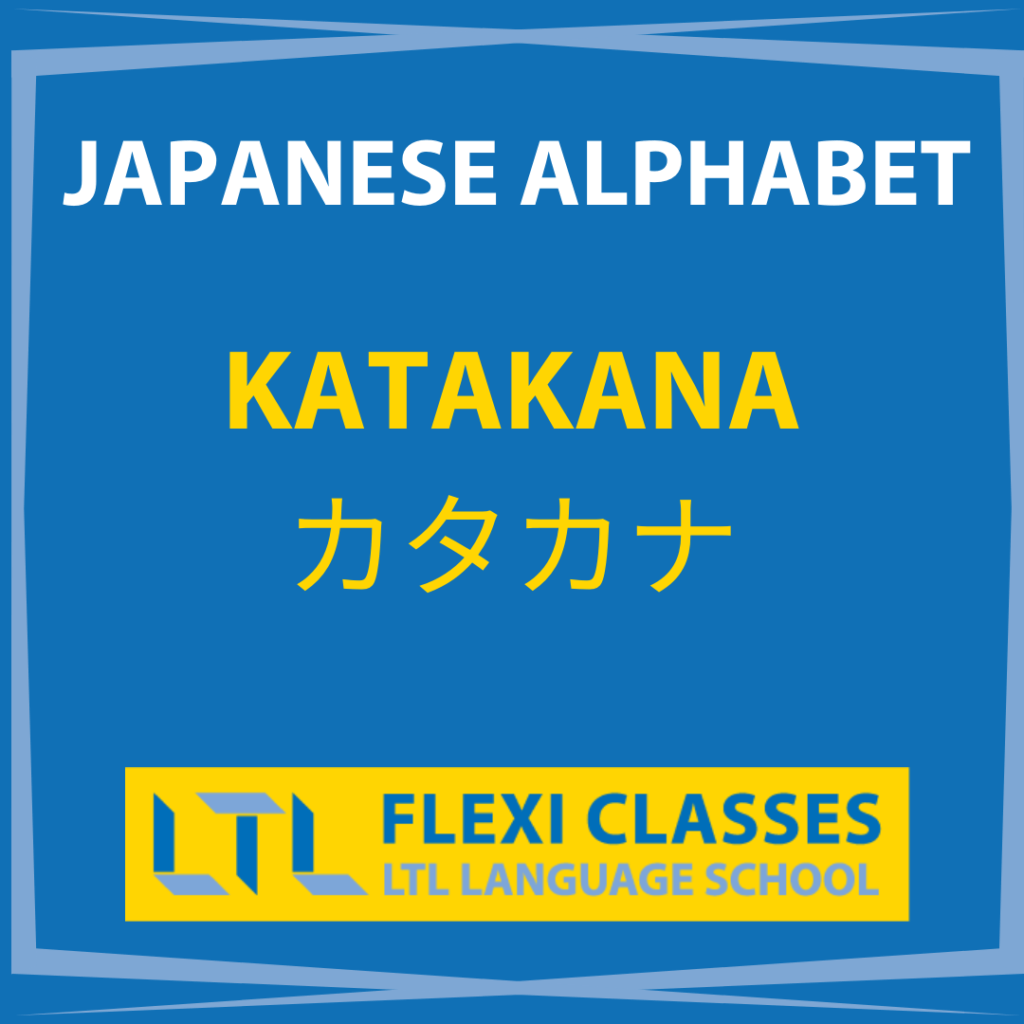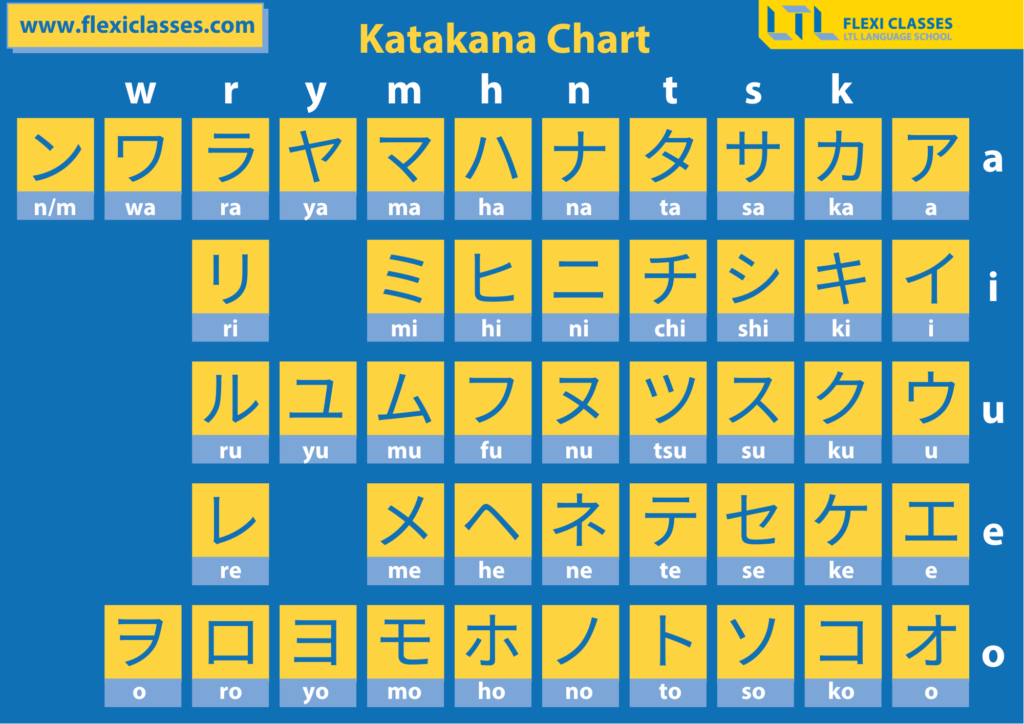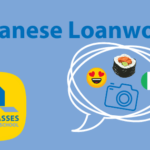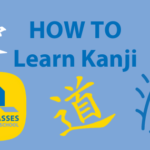How To Learn Katakana (カタカナ) // Essential Things To Know
Your Complete Guide on Katakana and How To Learn It
Right, so… How to learn Katakana? Well, you’re half-way there already (providing you’ve read our Hiragana article that is)!
Remember when you were terrified about learning hiragana?
Well, when answering the question “how to learn katakana”… it’s actually pretty darn similar to how you learnt hiragana.

They’re pretty much the same alphabet. Just, with different symbols?
What I mean by that is it’s the same concept.
There is no need to re-learn how to actually read the alphabet table or understand the consonant-vowel phonetic syllable system in Japanese.
You know that everything is ‘ka’, ‘ma’, bu’, ‘ni’ etc.
Each of these sounds is represented by one Hiragana and one Katakana.
FOR EXAMPLE – Take the sound “ma” in Japanese.
- Hiragana for the ma sound | ま
- Katakana for the ma sound | マ
Let’s try with another sound, this time “ki”.
- Hiragana for the ki sound | き
- Katakana for the ki sound | キ
You’ll find some Hiragana and Katakana with the same sound even look very similar, but we’ll come to that shortly.
Firstly, and we cannot stress this enough…
DISCLAIMER – This one is important. If you haven’t learnt hiragana yet, I recommend you first learn Hiragana before setting out on your journey on how to learn Katakana.
Link right here for you 👇👇👇

How to Learn Hiragana (Quickly) // 7 Terrific Tips To Success
How to Learn Hiragana? It might seem difficult but Hiragana can be understood within a few hours. Follow these tips for success and start reading Hiragana.
Hiragana is much more widely used and is needed for beginner Japanese.
You’ll also learn some basic things about how Japanese sounds work and how to actually read that complicated looking table that I promise makes more sense very quickly!
So let’s waste no time and get down to the best ways on how to learn katakana, as well as why you need to learn it in the first place!
How to Learn Katakana – What is Katakana?
How to Learn Katakana – How To Use Katakana?
How to Learn Katakana – Recognising Katakana
How to Learn Katakana – Tips & Tricks
How to Learn Katakana – TOP TIP
BONUS – QUIZ TIME
How to Learn Katakana – FAQ’s

How to Learn Katakana // What Is Katakana?
Before you go onto how to learn Katakana, first take some time to understand what Katakana is.
Katakana is one of the three alphabets of Japanese.
Actually, personally I believe that Japanese only has two alphabets and that Kanji (the Chinese characters) can’t be called an alphabet.
That is after all what kanji is, characters. Not an alphabet. Anyway, that’s just a matter of my opinion!
Nevertheless, Katakana and Hiragana can both definitely be called alphabets.
And the funny thing is, both alphabets represent the exact same sounds…
Want proof? Check out our Hiragana and Katakana tables side by side.


This is normally followed by the questions, why do we need katakana in the first place, and how is katakana used?
Well, I’m glad you asked…
How to Learn Katakana // How To Use Katakana?
If the symbols represent the exact same sounds as Hiragana, what’s the point? Why use katakana?
That’s like having two different symbols for the letter ‘p’, right?
Actually, that’s wrong!
In Japanese, in one sentence you could have both Hiragana, Katakana, and Kanji.
FOR EXAMPLE – 私はゾイです。’Watashi wa Zoe desu.’ Meaning, “I am Zoe”.
Can you spot the Katakana in that sentence?

Let’s break it down…
- 私 = Kanji, meaning “I”, or “me”.
- は = Hiragana, particle marker, showing “I” as the subject.
- ゾイ = Katakana, literally pronounced as ‘ZO-I’
- です = Hiragana, verb ‘to be’.
So looking at the sentence again… the katakana is in bold/brackets.
私は(ゾイ)です。
This is a great example of WHY and HOW we use hiragana.
It’s used in various contexts, including exaggeration etc, but really Katakana is mainly used for foreign origin words, including foreign names and country names.
So in the above example, we see Katakana is used for the foreign name “Zoe”… and the same will be true for all names…
- James (ジェームズ)
- David (デビッド)
- Jess (ジェス)
- Anna (アンナ)
See how they all use Katakana? If you refer to the Katakana table above you will see they all sound pretty much the same as their English counterparts.

ANOTHER FEW EXAMPLES:
- イギリス ‘igirisu’ – England
- アルバイト ‘arubaito’ – Part-time work (from the German ‘arbeit’)
- テーベル ‘taberu’ – Table
- グラス ‘gurasu’ – Glass
- イタリア ‘Itaria’ – Italy
Why don’t you have a go at figuring out your own name in Japanese?
Use the Katakana table above and comment below with your Japanese name!
If you are not sure, comment your name and we’ll translate your name to Japanese using Katakana.
How to Learn Katakana // Recognising Katakana
I don’t know about you, but Hiragana sounds like it reads, and Katakana sounds like it reads, too.
Hiragana sounds softer, more flowy. More curvy.
Katakana sounds rough, with sharp edges.
Interestingly, historically Hiragana was actually the script associated towards females of Japan and Katakana the males. It kind of makes sense with Hiragana known more for its beauty and curves, with Katakana known more for it’s blade/structured look, let’s say!
A number of Katakana symbols are actually pretty similar to their Hiragana counter-part and some are even exactly the same.
But as mentioned, Katakana is generally a bit sharper and angular than the curvy Hiragana.
FOR EXAMPLE ‘ya’ in hiragana is や, and ‘ya’ in katakana is ヤ.
Not an awful lot of difference is there!
Others are different and the way to learn them is to simply memorise and get familiar with them.
This video is one we like a lot for learning Katakana as it helps picture each symbol to something we are familiar with…
How to Learn Katakana // Tips & Tricks
Now we finally get to tips on how to learn Katakana – hopefully as quickly an efficiently as you did Hiragana!
If those tips worked for you for Hiragana, try them with learning Katakana, too.
Since these alphabets are pretty similar, Katakana should be much easier to learn now you’ve already conquered Hiragana.
Let’s go through the basic tips again, click on any you wish to read again/recap.
- Tip 1 (Don’t Panic)
- Tip 2 (Understand The Concept)
- Tip 3 (Understand The Hiragana Table)
- Tip 4 (Practice Everyday)
- Tip 5 (Read Everyday)
- Tip 6 (Print The Hiragana Table)
- Tip 7 (WATCH OUT For These Things)
Go in there slowly and first learn the vowels.
Then the next row of consonants plus vowels.
The next day, add on another row… and by the end of the week, if you’ve been practicing every day, you should at least (maybe with some help) be able to read and recognise most of the symbols on the Katakana table.
Let’s show you the table again below. How many do you know?

How to Learn Katakana // TOP TIP
So now you know that Katakana is used mainly for foreign origin words, this makes it a lot more fun to learn!
Is it actually a lot easier to learn Katakana than Hiragana.
Since Katakana is usually used on English loan words, why not practice your Katakana on the English loan words? This way it’s a lot of fun and actually very rewarding!
You never knew you understood this much Japanese already, right?!
We gave you some examples before… but here’s some more.
Doesn’t get much easier than that does it – oh and by the way if you want to learn a load more Japanese loanwords, check our blog out here 👇👇👇.

Japanese Loanwords 🤩 41 You Should Learn Straight Away
Japanese Loanwords are actually a great way to boost language learning motivation because it makes you realise you can still find similarities with English!
Actually, there’s a whole world of vocabulary you already know in Japanese if you know English.
Learning Katakana will help you to unlock that!
Start off with these 10 common English loan words written in katakana below.
Try covering up the pronunciation if you feel more confident when reading katakana, and if you’re super confident, cover up the English too and see if you can work out the words by yourself.
Some of them take a bit of imagination, since Japanese doesn’t have some letters such as ‘L’ or “V”. This merely adds to the fun…!
- Bar | バー (Baa)
- Bus | バス (Basu)
- Club | クラブ (Kurabu)
- Elevator | エレベーター (Erebeetaa)
- Escalator | エスカレーター (Esukareetaa)
- Event | イベント (Ebento)
- Guide | ガイド (Guaido)
- Hotel | ホテル (Hoteru)
- Restaurant | レストラン (Resutoran)
- Toilet | トイレ (Toire)
Once you’ve mastered how to learn Katakana and Hiragana, you’re almost there!
Now it’s just Kanji to tackle… but that’s for another day! Take baby steps, it’s a marathon not a sprint remember.
Whilst learning Katakana and Hiragana might take you a few weeks, Kanji will most likely take a few months or indeed a few years.
With thousands of them, it’s actually a never-ending learning curve, very similar, or in fact, exactly the same as learning Chinese, as there is no alphabet.

How To Learn Kanji // The Ultimate Tips & Tricks You Should Know
How to learn Kanji? Generally, you’ll need to learn about 1,000-2,000 Chinese characters in Japanese. Here’s the best way to go about learning them.
If the alphabets and languages of Asia fascinate you then we’ve got a few more entries we think you’ll like such as:
- The Alphabet of Korea – Discover Hangul
- Vietlish – It’s Vietnamese + English
- Our favourite Chinese Loanwords
There’s plenty more where that came from!
How to Learn Katakana // QUIZ TIME
OK time to put your knowledge to the test.
We’ve prepared a nice, friendly quick-fire Katakana quiz for you.
Don’t worry, it’s only 20 questions, can be completed really fast, and results are instant!
If you nail it with a big score, why not share it with us below…?!
How to Learn Katakana // FAQ’s
How is “Katakana” written in the Katakana script?
カタカナ, each symbol represents a syllable.
For example, you can guess カ means “ka” in Japanese easily!
How do Hiragana and Katakana differ?
Hiragana is more cursive whereas the Katakana letters are more angular in shape.
This makes it really easy to differentiate between which alphabet is being used on paper or on screen.
Here are some Hiragana – おはよう (this means today)
Here are some Katakana – カメラ (this means camera)
See the differences?
What are some examples of words in Japanese that use Katakana and are similar to English?
There are loads but here’s ten to prove it’s not all that bad to learn Japanese!
Bar | バー (Baa)
Bus | バス (Basu)
Club | クラブ (Kurabu)
Elevator | エレベーター (Erebeetaa)
Escalator | エスカレーター (Esukareetaa)
Event | イベント (Ebento)
Guide | ガイド (Guaido)
Hotel | ホテル (Hoteru)
Restaurant | レストラン (Resutoran)
Toilet | トイレ (Toire)
Can a Japanese sentence include all three alphabets?
Yes and most do in fact. Here is a very basic example:
私は(ゾイ)です。
This translates to “My name is Zoe” and includes all 3 of Hiragana, Katakana and Kanji
Do the Hiragana and Katakana of the same sound look similar when written?
Some do but most don’t.
For example the sound “ma” in Japanese is represented as follows:
Hiragana for the ma sound | ま
Katakana for the ma sound | マ
You can see these look quite different.
How many Japanese Alphabets are there in total?
There are 3 in total.
These are Hiragana, Katakana and Kanji.
What is England in Japanese Katakana?
イギリス which is pronounced “i gi ri su”.
Want More From LTL?
WANT TO LEARN JAPANESE? Check out our online Japanese courses here.
We offer a 7-day free trial to all new students where you can study 24/7.
What about studying Japanese in Japan instead? We’ve got your back. Our Japanese courses in Tokyo can either be taken in small groups of no more than 5 students or individually for a more tailored experience.
We even offer incredible homestay experiences in Tokyo as well.
Come and be a part of this amazing community.














10 comments
Katakana is beautiful to look at
We wholeheartedly agree!
I got 100% in the quiz! The blog was such a great help and i love your charts which I downloaded, thanks!
Amazing!!! You've nailed it JJ - thanks for sharing.
3 alphabets in one language 😂
Give it time and it makes a lot of sense Jess!! Beautiful scripts too!
Your blog is so extensive for these learning topics! Thanks LTL and Lex!!
Thanks Alex!! So kind
I like the duolingo tutorials on katakana
Yes the alphabet lessons are useful we agree!